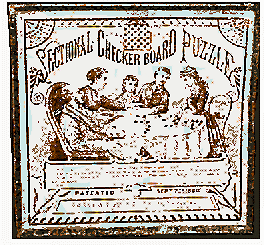David Palette in The Oxford History of Board Games (Oxford University Press, 1999, pages 162-163) explains that a "domino" is really two squares put together. "... mathematicians call a shape made of three squares stuck together a tromino, of four a tetromino, five a pentomino, and so on." Checkerboard puzzles are composed of a number of these shapes.

This relatively contemporary edition of a checkerboard puzzle was acquired by the Museum in 1972. It is composed of 13 pieces, which when assembled makes a board of 21.6cm long x 18.9cm wide. The pieces are made of thin cardboard cut into the five pentomino shapes. The puzzle was made by ABC Game Company, Denver Colorado, USA.
A version of a checkerboard puzzle known as "The Game of Pentominos", was devised by the American mathematician Solomon W. Golmb. The puzzle has 12 puzzle pieces that are composed of five squares each. One piece has the five squares in a row, a second piece is shaped like the letter "L", a third piece is shaped like the letter "W", and so on. The object of this game is to put the pieces together to form an 8x8 checkerboard, however, 4 squares will be uncovered. The challenge is to arrange the 12 pieces so the four empty squares "... occur in symmetry, such as all four in the middle, or one at each corner."

Puzzles pieces derived from an 8x8 checkerboard which has been cut into different shapes, are sometimes classified as Put-Together Puzzles, sometimes as a type of Jigsaw Puzzle, but usually as just a Checkerboard Puzzle. The origins of this type of puzzle may be very old, but contemporary versions appear to date from the late 19th century. To see examples and learn more about 19 Century Jigsaw Puzzles, click on the menu item in the left panel. According to Jerry Slocum and Jack Botermans (Puzzles Old & New, Seattle: University of Washington Press, 1986, ISBN 0-295-96579-7), the puzzle can be made from a cardboard checkerboard, a wooden board, or a metal board. Examples are available of checkerboards cut into 12 pieces, 13 pieces, 14 pieces, and more. They report that over 50 manufacturers designed at least 33 different 8x8 checkerboard puzzles since the late 19th century.
Anne Williams (the guest curator for Jigsaw Puzzles on this Website), indicates that Checkerboard Puzzles are not really Jigsaw Puzzles. She points out that these puzzles - unlike the typical jigsaw - often have more than one solution. Depending upon the number of pieces, there are usually multiple ways to assemble the pieces in order to reconstruct the 8x8 board.
The following is an other example from the collection.

This puzzle was purchased by the Museum in 1981. It is an original edition manufactured by Selchow & Righter in 1880.
According to Slocum & Botermans, Luers obtained a US patent for this puzzle, which consists of 15 differently shaped pieces. When assembled the 15 pieces make a board that is 20cm square. The pieces are made of thick cardboard.
The box in which the pieces are placed measures 21cm square and 1.75cm high. Though now somewhat faded, the picture on the box top was originally colored.

This is a contemporary Pentomino Puzzle in the collection. The 12 plastic pieces are made of five squares joined edge to edge to form different shapes. A square with a hole in the middle can be constructed from the pieces. Van Delft (pages 40-43) indicates thousands of ways to use the pieces to make a square, but only 65 solutions result in a central hole! Many other figures can be made from the pieces. This copy was manufactured by Kohner Bros. Inc., and is an example of the many types of plastic puzzles on the market today.
NOTE: This page was originally created and posted on the Web on October 6, 1997. Subsequently it has been modified and periodically updated. Last update April 7, 2010